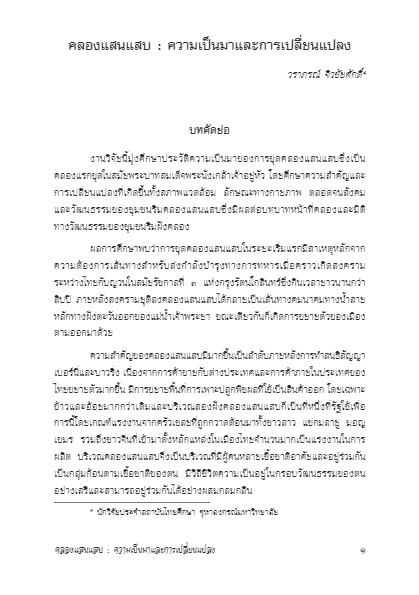วราภรณ์ จิวชัยศักดิ์
บทคัดย่อ
งานวิจัยนี้มุ่งศึกษาประวัติความเป็นมาของการขุดคลองแสนแสบ ซึ่งเป็นคลองแรกขุดในสมัยพระบาทสมเด็จพระนั่งเกล้าเจ้าอยู่หัว โดยศึกษาความสำคัญและการเปลี่ยนแปลงที่เกิดขึ้นทั้งสภาพแวดล้อม ลักษณะทางกายภาพ ตลอดจนสังคมและวัฒนธรรมของชุมชนริมคลองแสนแสบซึ่งมีผลต่อบทบาทหน้าที่คลองและมิติทางวัฒนธรรมของชุมชนริมฝั่งคลอง
ผลการศึกษาพบว่า การขุดคลองแสนแสบในระยะเริ่มแรกมีสาเหตุหลักจากความต้องการเส้นทางสำหรับส่งกำลังบำรุงทางการทหารเมื่อคราวเกิดสงครามระหว่างไทยกับญวนในสมัยรัชกาลที่ 3 แห่งกรุงรัตนโกสินทร์ซึ่งกินเวลายาวนานกว่าสิบปี ภายหลังสงครามยุติลงคลองแสนแสบได้กลายเป็นเส้นทางคมนาคมทางน้ำสายหลักทางฝั่งตะวันออกของแม่น้ำเจ้าพระยา ขณะเดียวกันก็เกิดการขยายตัวของเมือง
ตามออกมาด้วย
ความสำคัญของคลองแสนแสบมีมากขึ้นเป็นลำดับภายหลังการทำสนธิสัญญาเบอร์นี่และบาวริ่ง เนื่องจากการค้าขายกับต่างประเทศและการค้าภายในประเทศของไทยขยายตัวมากขึ้น มีการขยายพื้นที่การเพาะปลูกพืชผลที่ใช้เป็นสินค้าออก โดยเฉพาะข้าวและอ้อยมากกว่าเดิมและบริเวณสองฝั่งคลองแสนแสบก็เป็นที่หนึ่งที่รัฐใช้เพื่อการนี้ โดยเกณฑ์แรงงานจากครัวเชลยที่ถูกกวาดต้อนมาทั้งชาวลาว แขกมลายู มอญ เขมร รวมถึงชาวจีนที่เข้ามาตั้งหลักแหล่งในเมืองไทยจำนวนมากเป็นแรงงานในการผลิต บริเวณคลองแสนแสบจึงเป็นบริเวณที่มีผู้คนหลายเชื้อชาติอาศัยและอยู่ร่วมกันเป็นกลุ่มก้อนตามเชื้อชาติของตน มีวิถีชีวิตความเป็นอยู่ในกรอบวัฒนธรรมของตนอย่างเสรีและสามารถอยู่ร่วมกันได้อย่างผสมกลมกลืน
คลองแสนแสบได้รับการพัฒนา ปรับปรุง พร้อมทั้งรัฐได้จัดการบริหารการปกครองในท้องที่บริเวณสองฝั่งคลองให้เหมาะสมตามลำดับ จนในปัจจุบันมีเขตการปกครองที่มีคลองแสนแสบพาดผ่านถึง 18 เขต คลองแสนแสบที่มีประวัติยาวนานร่วม 200 ปีจึงยังคงเป็นเส้นทางน้ำที่แม้จะลดบทบาทในการเป็นเส้นทางคมนาคมหลักไป แต่ก็ยังคงมีฐานะเป็นคลองสำคัญในประวัติศาสตร์และเป็นเส้นทางสัญจรทางเลือกของคนกรุงเทพฯและเขตชานเมือง อีกทั้งยังเป็นแหล่งน้ำที่มีประวัติทางวัฒนธรรม มีความหลากหลายทางชาติพันธุ์ที่น่าสนใจอีกด้วย
(ตีพิมพ์ใน วารสารไทยศึกษา ปีที่ 8 ฉบับที่ 2 (สิงหาคม 2555 – มกราคม 2556) หน้า 1-23)
Saensaeb Canal : History and Development
Waraporn Chiwachaisak
Abstract
This research aims at studying the history of Saensaeb Canal, the first canal to be dug in the reign of King Rama III. The study focuses on the importance of the canal and the environmental, physical, social and cultural changes which have affected the role of the canal and the cultural dimension of the communities along the canal.
The research found that the need to carry military supplies during the long-lasting war between Thailand and Vietnam during the reign of King Rama III of the Rattanakosin period was the main reason for digging the Saensaeb Canal. After the war, the canal became a waterway artery on the east side of the Chao Phraya River when the city was extended along the canal.
The importance of the Saensaeb Canal increased after the signing of the Burney and Bowring Treaties when there was an increase in local and international trade in Thailand. Also, plantations, especially rice and sugar cane, were expanded for exports. The land on the banks of the Saensaeb Canal was used for agricultural purposes, worked by a large number of war captives who were Lao, Malay, Mon, Khmer, as well as by Chinese laborers who had settled in Thailand. These ethnic groups lived in their own communities, freely led their traditional ways of life, and peacefully co-existed along the canal.
As time went by, the Saensaeb Canal was developed and improved. The government provided appropriate administration for the people on both sides of the canal. To date, there are 18 districts under the Bangkok Metropolitan Administration along the canal. The Saensaeb Canal, which was dug almost 200 years ago, is one of the most important canals in the history of Thailand, although it is no longer one of the main waterways. However, the Saensaeb Canal is an alternative traff ic route for people in Bangkok and its suburbs and an interesting canal with a diverse cultural heritage.
(Published in Journal of Thai Studies Volume 8 Number 2 (August 2012 – January 2013) Page 1-23)
บทความ / Full Text : Download
